Ethiopia
![]() Ethiopia is the tenth largest country of Africa and covers 1,138,512 square kilometers of most of what is known the Horn of Africa. About a hundred million people live in Ethiopia. The country looks back on a long history. The legend of the Queen of Sheba which dates back 25 centures, is connected with the rise of the Abyssinian Empire.
Ethiopia is the tenth largest country of Africa and covers 1,138,512 square kilometers of most of what is known the Horn of Africa. About a hundred million people live in Ethiopia. The country looks back on a long history. The legend of the Queen of Sheba which dates back 25 centures, is connected with the rise of the Abyssinian Empire.
Location

(c) NordNordwest
Ethiopia lies in the east of Africa. It is a landlocked country surrounded by Sudan, Kenia, Somalia and Eritrea. The country has no access to the Red Sea. Ethiopia is known for the Abyssinian Highlands. These mountainous Highlands could be compared to the highlands in Scotland. The source of the Blue Nile river is also in the Highlands. Lake Tana is the largest lake in Ethiopia.
Landscapes
 The Ethiopian Highlands are called The Roof of Africa. They are also simply spectacular. They contain the largest continuous area of high altitude land in the whole of the continent. The Great Rift Valley runs through the center, splitting the Highlands in two. In earlier times, dense forests of Acacia and Baobab trees grew on the Highlands. As a result of forest clearing, many plants and animals have disappeared. Some of the oldest plants in the world still survive in the savannahs and rainforests. Coffee originates from Ethiopia’s Kaffa Province.
The Ethiopian Highlands are called The Roof of Africa. They are also simply spectacular. They contain the largest continuous area of high altitude land in the whole of the continent. The Great Rift Valley runs through the center, splitting the Highlands in two. In earlier times, dense forests of Acacia and Baobab trees grew on the Highlands. As a result of forest clearing, many plants and animals have disappeared. Some of the oldest plants in the world still survive in the savannahs and rainforests. Coffee originates from Ethiopia’s Kaffa Province.
The Blue Nile
The source of the Blue Nile pours out of Lake Tana in the Ethiopian Highlands and flows south from Lake Tana and then west across Ethiopia and northwest into Sudan. The locals call the Blue Nile Abbay, according to its “earthy” colour. Only some kilometres from its source at Lake Tana, the river enters a canyon about 400 kilometres long. This gorge is a tremendous obstacle for travel and communication from the north half of Ethiopia to the southern half. It plunges more than 2,000 metres in its 800-kilometres course from Ethiopia to the Sudanese plains, where the Blue Nile units with the White Nile to become the biggest river on earth. Two power plants curb the power of the river. Only on Sunday the power plants are shut down for some hours to attract tourists to the spectacular Blue Nile Falls.
Addis Ababa, the Capital of Ethiopia
Addis Abeba, the capital city of Ethiopia, is located in the Abyssinian Highlands. The name means “new flower”. The area was once the residence of the medieval emperors. At the end of the 19th Century, emperor Menelik II’s wife transformed the residence into a city. Today, Addis Ababa is Africa’s political centre. The headquarters of the African Union is in Addis Ababa, and also more than hundred international missions and embassies are based there. Addis Ababa is Africa’s fourth largest city with about four million inhabitiants. It has a new central business district, with five-star hotels, banks and gleaming office blocks. But it is still surrounded by huge slums. The government tries to “clean” the city from the slum dwellers and to create a model on the continent. But there ist much protest against this plan because the poor people don’t know where to go and also they cannot afford to pay a rent or to buy a house.

(c) wikitravel
Homelessness in the capital is a serious social problem, especially among the youth. Many street children resort to theft to feed themselves. Police officers usually apprehend thieves but rarely prosecute and often work with them, splitting the bounty.
Peoples and Languages
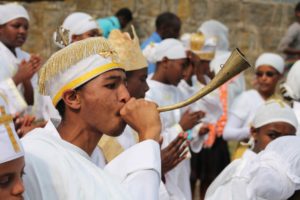
The first Greek scholars who visited the Abyssinian Highlands named the region ethio, meaning “burned” and pia , meaning “face”: the land of burned-faced peoples. Today Ethiopia is called the land of languages. Over 70 different languages are spoken across the country. The reason is that the Ethiopians comprise many different peoples, including the Oromo, Amhara, Tigrai, and many more. Under the country’s constitution, all local languages in Ethiopia have official state recognition. The Amharic is used as the language of communication in many parts of the country and also by the government. All local languages are valued, they have official state cognition.Christianity came to Ethiopia in the fourth century. Still, the Ethiopian Orthodox Church plays an important part in the country’s culture, festivals and visual arts. Islam was introduced in the seventh century and is now practised by about one-third of Ethiopians, mostly in eastern regions. The structure of the society is still very traditional and patriarchal. The oldest male is usually the head of the household and is in charge of decision making. Men, usually having the primary income, control the family economically and distribute money. Women are in charge of domestic life and have significantly more contact with the children. The father is seen as an authority figure. Gender inequality is still prevalent. In urban areas many women work outside of the home, and there tends to be a greater awareness of gender inequality. Employment at a baseline level is fairly equivalent, but men tend to be promoted much faster and more often.
Ethiopian Celebrations
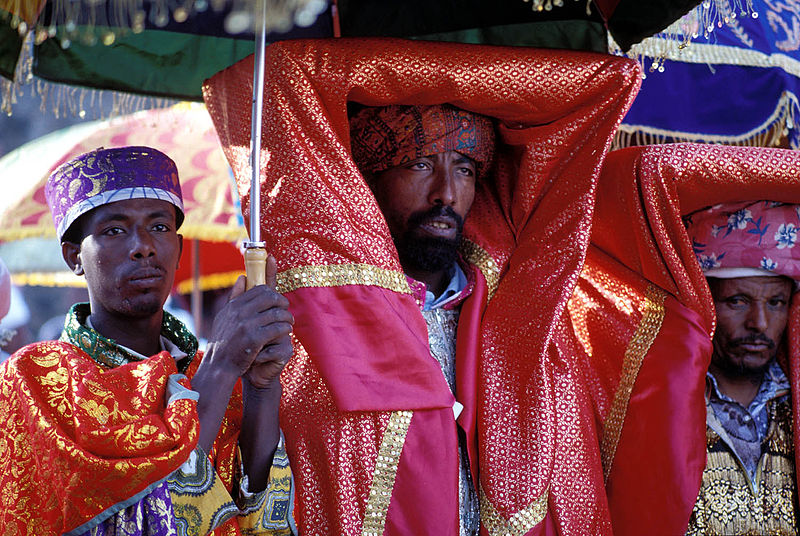 Most Ethiopians are Christians and celebrate the same occasions as we do. The most important celebration is Fassika at Easter. Easter is celebrated later in the year as the Ethiopian calendar has not 12, but 13 months. In the two months before Easter, Ethiopians observe a strict fasting period. They do not consume any meat, milk or butter during this time. When Easter arrives they enjoy a feast of lamb goulash and flat bread. In the eastern regions, major Islamic festivals such as Eid Al-Fitr are also official holidays.
Most Ethiopians are Christians and celebrate the same occasions as we do. The most important celebration is Fassika at Easter. Easter is celebrated later in the year as the Ethiopian calendar has not 12, but 13 months. In the two months before Easter, Ethiopians observe a strict fasting period. They do not consume any meat, milk or butter during this time. When Easter arrives they enjoy a feast of lamb goulash and flat bread. In the eastern regions, major Islamic festivals such as Eid Al-Fitr are also official holidays.
Ethiopian Cultures

(c) The Photographer
Ethiopia is the homeland of the Rastafari movement, which globalized its flag colors worldwide via pop culture and Reggae music. Foreign influences in pop culture exist in the form of Afro-pop, reggae, and hip-hop. However, Ethiopia’s musicians and bands have a very unique sound, influenced by the rhythms and music of the various people. A national pop star is Theodros Kassahun. Also Aster Aweke is well-known, she has been making albums for over 30 years as well as her acknowledged disciple Gigi. Tv isn’t a leading media in Ethiopia since only a few people can afford to buy a tv device. But since the popular tv show Ethiopian Idols is aired everyone wants to have a device. This show has fast won the highest ratings on otherwise dull state-run TV. The catchphrase of musician Feleke Hailu -“alta fakedem” or “you didn’t make it” in Amharic has caused a sensation in this tradition-bound culture because in Ethiopian culture it is not common to tell the truth or criticise. People cannot take criticism. But gradually people became addicted to the show because it was so refreshing to hear a guy saying the truth.
Pop Cultures
Ethiopia is a country where the old traditions are still cultivated and valued. Part of the young Ethiopians, especially those who have no jobs don’t feel so much connected to their old traditions, because these traditions don’t help them to survive. It is the law of the jungle that dominates their life and their communities. Street gangs dominate the business in the urban centres, they deal with whatever is available and desired, drugs, all kinds of luxury goods and also services of all kind. Skating has become the sport of some of the young people, and has developed into an urban culture. A skate board isn’t very expensive, and because of the high unemployment many young people have time in abundance. Sport clubs call for competition, and some can make a living of it.
Schools, Colleges and Universities
 The government provides free access to education. However, remaining costs for uniform and books make schooling unaffordable for some poor families in the long term. And in remote rural areas, only one third of the children go to school. Class sizes are large and schools are often in poor repair. However, the government is funding new schools and the training of many more teachers to cope with an increase in pupil numbers. School is compulsory until a child is 12 years old. Most children will have left school by this age, particularly if they are from poor families. They take on agricultural work at home, or work in local cottage industries. University is free, but admission is extremely competitive. Every secondary student takes a standardized examination to get into college. The acceptance rate is approximately 20 percent of all the individuals who take the tests.
The government provides free access to education. However, remaining costs for uniform and books make schooling unaffordable for some poor families in the long term. And in remote rural areas, only one third of the children go to school. Class sizes are large and schools are often in poor repair. However, the government is funding new schools and the training of many more teachers to cope with an increase in pupil numbers. School is compulsory until a child is 12 years old. Most children will have left school by this age, particularly if they are from poor families. They take on agricultural work at home, or work in local cottage industries. University is free, but admission is extremely competitive. Every secondary student takes a standardized examination to get into college. The acceptance rate is approximately 20 percent of all the individuals who take the tests.
Economy and natural Resources
 Ethiopia is known as the land of coffee. In the tenth century nomadic people may have been the first to recognize the stimulating effect of coffee. Since that time coffee is cultivated in Ethiopa. Most of the Ethiopiens live of agriculture. The central plateau of the country supports a huge population with one of the largest areas of fertile land in east Africa.Farmers grow vegetables, teff, which is a grain-producing grass, millet, maize, wheat, and beans for the local market. Many small-holders also grow coffee as a cash crop. Livestock rearing is also a common farming activity, with meat and skins from goats and sheep exported. Ethiopia has one of fastest-rising economies in Africa. However, many Ethiopian farmers struggle to make a living from their production. Half of the population lives on less than a dollar each day.
Ethiopia is known as the land of coffee. In the tenth century nomadic people may have been the first to recognize the stimulating effect of coffee. Since that time coffee is cultivated in Ethiopa. Most of the Ethiopiens live of agriculture. The central plateau of the country supports a huge population with one of the largest areas of fertile land in east Africa.Farmers grow vegetables, teff, which is a grain-producing grass, millet, maize, wheat, and beans for the local market. Many small-holders also grow coffee as a cash crop. Livestock rearing is also a common farming activity, with meat and skins from goats and sheep exported. Ethiopia has one of fastest-rising economies in Africa. However, many Ethiopian farmers struggle to make a living from their production. Half of the population lives on less than a dollar each day.
Is Ethiopia a poor country?

Ethiopia is a poor country, it ranks 174th out of 187 countries on the United Nations Development Programme’s human development index. About 29 per cent of the population lives below the national poverty line. Only 40 percent of the grown ups can read and write. Youth unemployment is high. The government has started several programms to support the industry. With the help of international donors Ethiopia has improved its school system and its technical and vocational education. It is key to creating prospects for the rapidly growing population. The past two decades universities and vocational schools have been built across the country. Today Ethiopia has 39 universities, compared with just two at the beginning of the 1990s. During the last five years, the number of vocational schools almost doubled to more than 900. This was urgently necessary because young people, most of all young women, still become the victim of traffickers who move them to Arabian countries as cheap labour.
Attractions
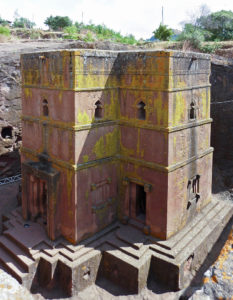
(c) Bernard Gagnon CCBYSA3.0
Ethiopia has amazing historical cities, monuments and places listed as UNESCO World Heritage sites. Some go back to prehistoric times where evidence of our earliest ancestors has been found. Our most promenent ancestor, Lucy, was found in Ethiopia. The ruins of the ancient city of Aksum tell of a once powerful kingdom in first–eighth centuries. Remains of this important historical site include tombs, castle ruins and giant stelae. In Ethiopia you can find the most spectecular ancient churches, called the Lalibela churches. The churches are carved out of solid rock, including the twelve rock-hewn monolithic churches of Lalibela. The town is named after the thirteenth-century king who supervised its construction. The construction of the churches is shrouded in mystery, and several are over thirty-five feet high. The most famous, Beta Giorgis, is carved in the shape of a cross. Each church is unique in shape and size. The churches are not solely remnants of the past but are an active eight-hundred-year-old Christian sanctuary. Many people are drawn to these amazing buildings, including pilgrims who come to Lalibela to celebrate Christian festivals.
History
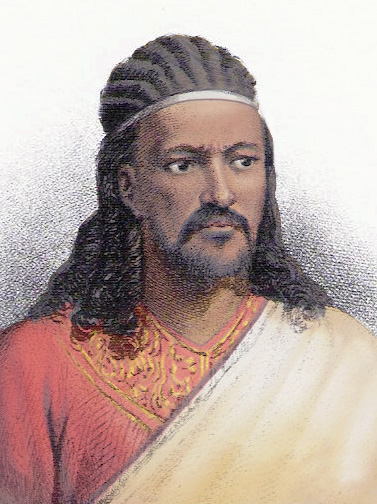
(c) gemeinfrei
Ethiopia is a very special country. Researchers have discovered some of the oldest signs of human life there. Scientists consider the region as origin from which the homo sapiens first set out for the Middle East and beyond. The Abyssinian Empire was formed in Ethiopia 10,000 years before Christ and is the oldest state in the world. According to legend, the Queen of Sheba’s son, Menelik, was the one who founded this empire. This is also where Aksum, the first Christian empire, was founded. The Aksumite Empire stretched as far as the Arabian territory. At the end of the 12th Century, King Lalibela founded a city in the Ethiopian desert, which was named after himself. Lalibela is still marvelled at today for its magnificent churches carved from huge rocks. In the 19th Century Tewodros II was in power and he fought for the independence of the Empire. In 1974, the Abyssinian Empire was overthrown. After a military dictatorship, a rebel group managed to take control of government.
Ethiopia Today
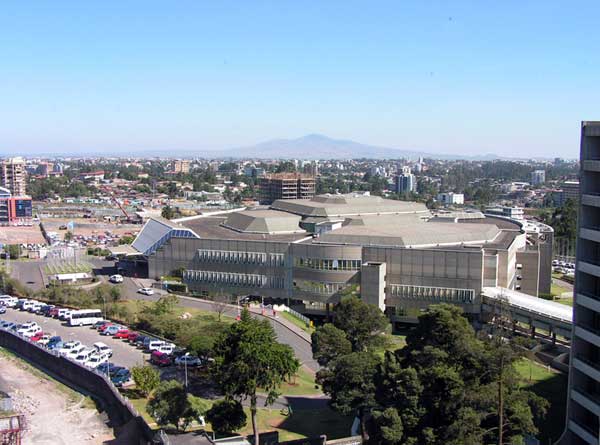 The last thirty years have been a time of revolt and political unrest but represent only a small portion of the time during which Ethiopia has been a politically active entity. Unfortunately, however, the country’s international standing has declined since the reign of Emperor Selassie, when it was the only African member of the League of Nations. War, drought, and health problems have left the nation one of the poorest African countries economically, but the people’s fierce independence and historical pride account for a people rich in self-determination. Ethiopia is old by its history but young by its peoples. Half of the population is younger than 18 years. Ethiopia has one of the fastest growing economies of Africa, but most of the people are poor. The economy struggles with a fast rising population. The government does much to improve the education system and to build more schools and universities.
The last thirty years have been a time of revolt and political unrest but represent only a small portion of the time during which Ethiopia has been a politically active entity. Unfortunately, however, the country’s international standing has declined since the reign of Emperor Selassie, when it was the only African member of the League of Nations. War, drought, and health problems have left the nation one of the poorest African countries economically, but the people’s fierce independence and historical pride account for a people rich in self-determination. Ethiopia is old by its history but young by its peoples. Half of the population is younger than 18 years. Ethiopia has one of the fastest growing economies of Africa, but most of the people are poor. The economy struggles with a fast rising population. The government does much to improve the education system and to build more schools and universities.



